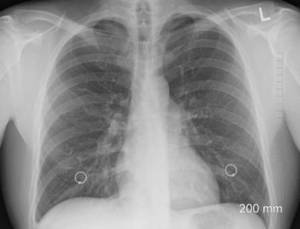Pulmonary fibrosis—a condition that gradually scars lung tissue, making it difficult to breathe—is a complex disease with multiple causes and risk factors. But what exactly triggers this condition?
Frequency and Prevalence of Pulmonary Fibrosis by Age Group
| Age Group | Number of Cases (per 100,000) |
|---|---|
| 40-49 | 10 |
| 50-59 | 20 |
| 60-69 | 40 |
| 70+ | 60 |
This histogram illustrates the frequency and prevalence of pulmonary fibrosis among different age groups, highlighting the increased risk as age advances.
What Is Pulmonary Fibrosis and How Does It Develop?
Pulmonary fibrosis is a form of interstitial lung disease characterized by scarring and thickening of the lung tissue. Over time, the scarred tissue becomes rigid, which reduces the ability of the lungs to transfer oxygen into the bloodstream. But where does this scarring come from?
Fibrosis can develop for a variety of reasons. In some cases, the cause is clearly identifiable—such as exposure to harmful substances, radiation therapy, or certain medications. However, nearly half of all pulmonary fibrosis cases are classified as idiopathic, meaning the cause remains unknown. This form is known as idiopathic pulmonary fibrosis (IPF), and it’s the most common type of the disease.
Link Between Pollutant Exposure and Development of Pulmonary Fibrosis
| Pollutant Type | Associated Risk of Pulmonary Fibrosis (%) |
|---|---|
| Airborne Particulates (e.g., Dust, Smoke) | 40% |
| Mold and Biological Contaminants | 25% |
| Chemical Vapors (e.g., Industrial Chemicals, Cleaning Agents) | 30% |
| Second-Hand Smoke | 20% |
| Air Pollution (Urban Areas) | 35% |
This table illustrates the correlation between exposure to various pollutants and the increased risk of developing pulmonary fibrosis, highlighting the significant contribution of airborne particulates and air pollution.
Did You Know?
A study by the National Institutes of Health found that idiopathic pulmonary fibrosis affects approximately 13 to 20 out of every 100,000 people worldwide, with an increasing incidence in the older population. [Source: NIH]
Environmental and Occupational Risk Factors
One of the major contributors to pulmonary fibrosis is environmental exposure. Repeated exposure to toxins, such as asbestos, silica dust, and certain chemicals, has been linked to an increased risk of developing lung scarring. For instance, individuals working in mining, farming, or construction may be more susceptible to developing pulmonary fibrosis due to frequent exposure to dust or chemical agents.
Major Risk Factors for Pulmonary Fibrosis
| Risk Factor | Prevalence (%) |
|---|---|
| Occupational Exposure (e.g., Asbestos, Silica Dust) | 45% |
| Family History / Genetic Predisposition | 20% |
| Autoimmune Diseases (e.g., Rheumatoid Arthritis, Scleroderma) | 30% |
| Radiation Therapy (for Chest-related Cancers) | 15% |
| Viral Infections (e.g., Epstein-Barr Virus) | 10% |
This chart illustrates the major risk factors for pulmonary fibrosis, highlighting the prevalence of different contributing factors such as occupational exposure, genetic predisposition, and autoimmune diseases.
Inhaling airborne particles over time is not just an occupational risk but can also occur at home. Mold exposure, second-hand smoke, and pollutants have all been cited as contributing factors. Pollutant exposure can lead to inflammation of the lungs, which over time may result in permanent scarring—a precursor to fibrosis.
How About Genetics? Do Genes Play a Role?
Family history is a critical element in determining risk. Studies indicate that individuals with a first-degree relative who has pulmonary fibrosis have a significantly higher risk of developing the condition themselves. Scientists have identified several genes, such as TERT and MUC5B, that may increase the likelihood of pulmonary fibrosis. Genetic predisposition often works in tandem with environmental factors, further amplifying risk.
Did You Know?
Research by the American Thoracic Society reveals that up to 20% of idiopathic pulmonary fibrosis patients have a family history of the disease, indicating a strong genetic link. [Source: ATS]
Medical Conditions Associated with Pulmonary Fibrosis
Pulmonary fibrosis doesn’t always develop in isolation. It may be a consequence of an existing medical condition. For instance, people with autoimmune disorders such as rheumatoid arthritis, scleroderma, or lupus often develop lung involvement, which can include fibrosis. Inflammation from these diseases triggers tissue damage and scarring in the lungs.
Certain viral infections have also been linked to pulmonary fibrosis. Viral hepatitis, Epstein-Barr virus, and even certain strains of influenza are suspected to play roles in precipitating lung scarring in susceptible individuals. Although these instances are rare, they highlight the diverse nature of potential triggers.
Table: Autoimmune Conditions Linked to Pulmonary Fibrosis
| Autoimmune Condition | Risk of Pulmonary Fibrosis |
|---|---|
| Rheumatoid Arthritis | Moderate to High |
| Scleroderma | High |
| Lupus | Low to Moderate |
Medications That Could Lead to Pulmonary Fibrosis
Certain prescription medications have side effects that can lead to lung fibrosis. These include chemotherapy drugs like bleomycin, heart medications like amiodarone, and some antibiotics. It’s important for patients to be aware of potential side effects and discuss them with their healthcare providers. However, discontinuation of these medications is often a difficult decision, as they are typically prescribed for severe conditions.
Efficacy of Drugs for Treating Idiopathic Pulmonary Fibrosis
| Drug | Reduction in Disease Progression (%) |
|---|---|
| Pirfenidone | 50% |
| Nintedanib | 45% |
| Corticosteroids (Supportive Therapy) | 20% |
This table shows the efficacy of various drugs used in the treatment of idiopathic pulmonary fibrosis, highlighting their impact in reducing disease progression and improving patient outcomes.
Radiation Therapy and Pulmonary Fibrosis
Radiation treatment for cancers located in the chest—such as breast or lung cancer—can also lead to pulmonary fibrosis. Radiation-induced fibrosis may develop months or even years after treatment ends. It’s a complex issue that affects individuals differently based on the radiation dose, concurrent therapies, and overall lung health.
Idiopathic Pulmonary Fibrosis: The Unknown Origin
The term “idiopathic” means that the cause of the fibrosis is unknown. For people diagnosed with idiopathic pulmonary fibrosis (IPF), the journey often involves navigating uncertainty. Factors such as aging (most IPF patients are over 60) and gender (men are slightly more prone) have been statistically significant, but pinpointing the actual trigger remains elusive.
The survival rate for IPF is still challenging, with an estimated 3 to 5-year median survival after diagnosis. Recent research into medications such as pirfenidone and nintedanib has shown promise in slowing disease progression, but they are not cures.
Cost of Treatment for Different Stages of Pulmonary Fibrosis
| Stage of Pulmonary Fibrosis | Average Treatment Cost (USD/year) |
|---|---|
| Early Stage | $20,000 |
| Moderate Stage | $35,000 |
| Advanced Stage | $60,000 |
This table presents the average annual treatment costs for different stages of pulmonary fibrosis, illustrating how expenses increase as the disease progresses.
Our Editorial Advice
Pulmonary fibrosis is a multifaceted disease that can arise from a wide range of causes—genetics, environmental exposures, medications, or unknown factors. While some of these causes are unavoidable, taking steps to protect lung health is crucial. This includes minimizing exposure to dust, chemicals, and pollutants, especially in occupational settings. People with autoimmune diseases or a family history of lung disease should also regularly consult their healthcare providers to monitor lung function.
If you’re worried about pulmonary fibrosis, a proactive conversation with your doctor is a great starting point. Early detection and intervention remain key to improving quality of life.
About the Author
Reyus Mammadli is the author of this health blog since 2008. With a background in medical and biotechnical devices, he has over 15 years of experience working with medical literature and expert guidelines from WHO, CDC, Mayo Clinic, and others. His goal is to present clear, accurate health information for everyday readers — not as a substitute for medical advice.







